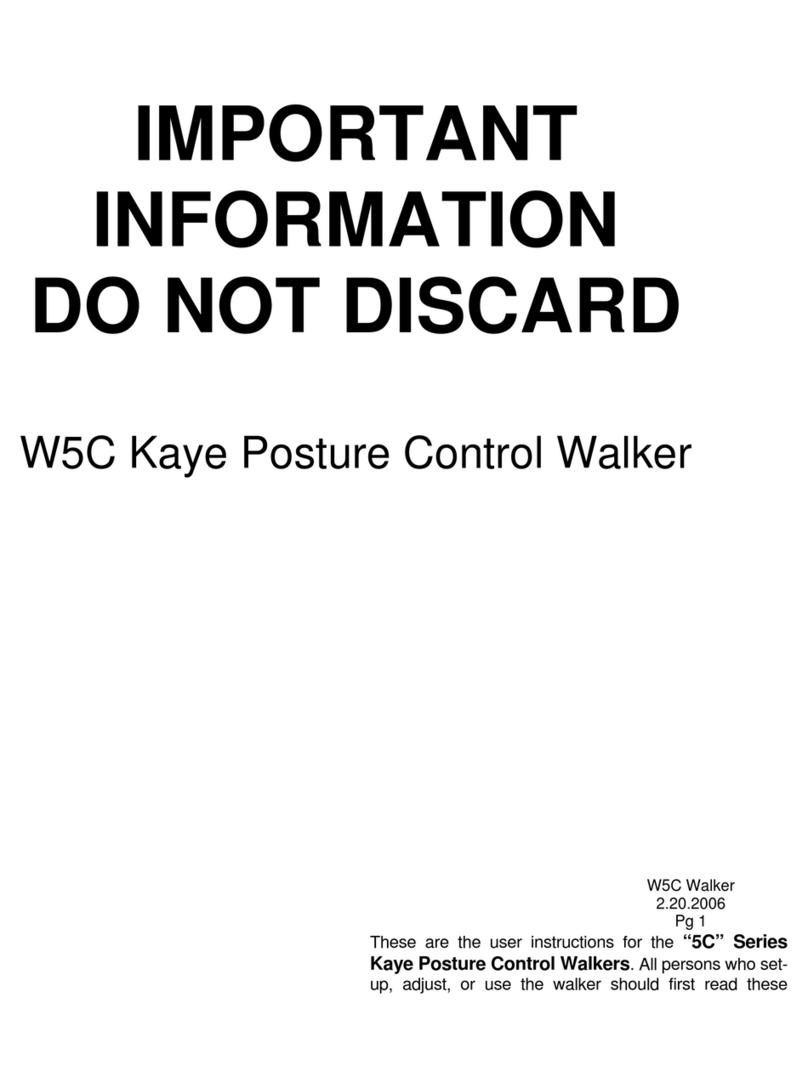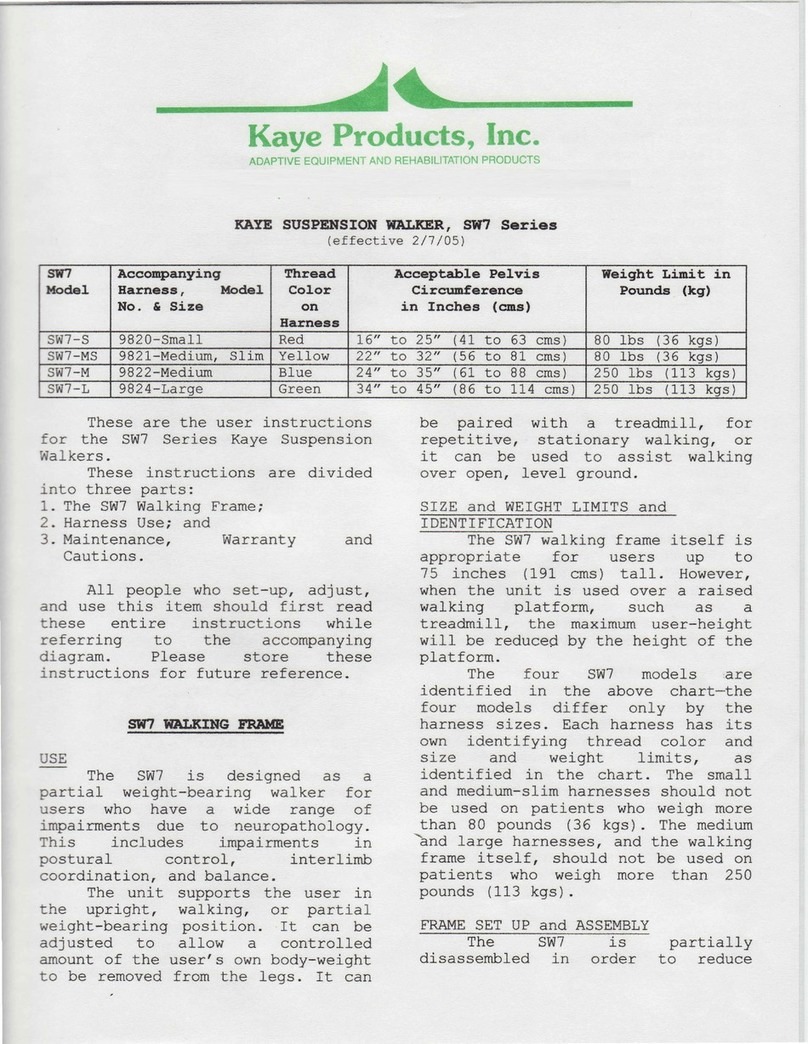
“B” Walkers, 2/02/04, page 2
ASSEMBLY
Some walkers are shipped with the legs
removed. Install the legs as follows:
1. The front legs have wheels that rotate in
both directions. Install the front leg with
the orange sticker into the front, left side
of the frame. Install the other front leg into
the front, right side of the frame.
2. Install the rear legs with tips so that
the bend points the tip towards the front of
the walker.
3. The rear legs with wheels have wheels that
rotate in only one direction. Install the rear
leg with the orange sticker into the rear,
left side of the frame. Install the other rear
leg into the rear, right side of the frame.
HEIGHT ADJUSTMENT
Adjust the height of the walker so that
the top, rear bar is aligned with the middle
of the user's buttocks. To do this, press the
pushpin on each leg and slide the leg up or
down as needed.
After installing or adjusting the legs,
always check the following:
1. All four extensions must be adjusted to
the same height.
2. The pushpins must protrude fully from the
adjustment holes.
3. The wheels should face towards the outside
of the walker.
4. If you have rear legs with tips, the bend
should point the tip towards the front of the
walker.
5. If you have swivel front wheels, the
plates should be parallel with the ground and
protrude from the walker as shown in Figure B.
6. If you have rear wheels, the locking
mechanism on the rear wheels should prevent
the walker from rolling backwards.
UNLOCKING AND LOCKING THE SWIVEL WHEELS
To unlock the front wheels so that they
swivel, rotate each swivel latch around and
down, as shown in Figure B, until it rests
against the bolt that serves as an axle for
the wheel.
To prevent the wheels from swiveling,
first point the wheel straight ahead as shown
in Figure B. Then rotate each latch around and
up until it is seated fully into the slot
located in the plate above the wheel.
ADJUSTING ALIGNMENT, SWIVEL WHEELS
Adjust the alignment of the swivel
wheels as follows:
1. Ensure that the swivel caster is locked as
shown in Figure B.
2. Use 1/2” wrenches to loosen bolt “X”.
3. Point the caster assembly in the desired
direction.
4. Securely tighten the bolt.
ADJUSTING NON-SWIVEL WHEELS, FRONT AND REAR
Use 9/16” wrenches to adjust the
optional, silent rear wheels. Use 3/4”
wrenches to adjust the front, “all-terrain”
wheels. Use 1/2” wrenches to adjust all other
wheels. A flat-head screwdriver may also be
needed.
Adjust the alignment of the non-swivel
wheels, front or rear, as follows:
1. If a bolt head, which is located on the
outside of the wheel, is concealed by a
plastic cover, remove that cover. To do this,
insert the tip of a flat-head screwdriver just
under the edge of the plastic cover and gently
pry the cover off of the metal flange. The
bolt head should then be visible.
2. Secure the bolt head on the outside of the
wheel so that it does not turn.
3. Loosen the nut that is located on the
opposite side of the leg as is the wheel.
4. If you have silent rear wheels, you may
also need to loosen the nut between the leg
and the wheel. To do this, move that nut away
from the leg. (It may be necessary to rotate
the bolt head in order to loosen this nut.).
5. Adjust the alignment as desired.
6. Move the wheel up or down to ensure the
walker is level.
7. Secure the bolt head that is on the
outside of the wheel so that it does not turn.
8. Identify the nut that is on the opposite
side of the leg as is the wheel. Securely
tighten that nut into the tube.
9. If you have silent rear wheels, identify
the nut that is between the wheel and the
tube. Securely tighten that nut into the tube.
OPTIONAL REAR LEGS WITH SILENT, ONE-WAY
BEARINGS
Rear leg extensions with silent, one-
way bearings are available as an option for
these walkers. Model RR1/2B fits W1/2B and
W1/2BH frames; RR1B fits W1B and W1BH frames;
RR2B fits W2B and R2B frames; RR3B fits W3B
and R3B frames; and RR4B fits W4B and R4B
frames.
Install these legs as described under
ASSEMBLY, step 3.
Adjust these legs as described under
ADJUSTING NON-SWIVEL WHEELS, FRONT AND REAR.
However, after adjustment, both nuts must be
tightened very securely against the tube, or
the following difficulties may occur:
1. When rearward pressure is applied, the
one-way bearing may turn the bolt. When
this occurs, the wheel can become
misaligned and/or become loose on the
leg. To correct this, adjust the wheel as
described in the previous section and























